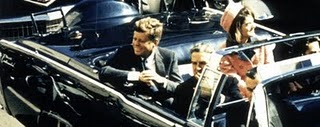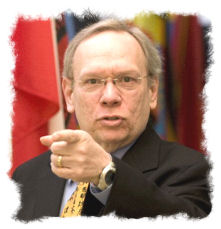
by Grover B. Proctor, Jr. (November 1997)
I stand alone beside the car in which
they killed John Kennedy.
An undulant morphing crowd of
gawking pedestrian tourists presses around—
unsure how to react, reminded of their own mortality,
repeating hushed words like talismans or omens
("Oswald, Jackie, Grassy Knoll, Oliver Stone"),
as if possession of them proves they know
the esoteric secrets of the event and somehow
gives them status above the uninitiated.
They bend to read the sign beside the roped-off icon,
which simply calls it the "Kennedy Car"—
easily and purposefully evoking memories
of "when it was a blue convertible
in the bright Dallas sun."
The museum doesn't sell the picture postcard
of this infamous "X-100" 1961 Lincoln anymore;
the gift shop managers don't know why not,
and so can merely shrug each time they're asked.
Disappointed, the crowd moves on.
Bitter steel and sullen glass (in truth,
titanium armoring and bullet-proof windows)
now entomb the open seat from which the president
gave his final wave, flashed the ultimate smile,
and unknowingly witnessed his last hurrahs.
It doesn't take much imagination to still see,
in vivid unimpeachable mental celluloid,
the awful moment when the light was blown out,
and national innocence died in that car.
With it, some say, went hope, inspiration, and vigor.
Leaders who see futures, set courses, provoke change,
and defy both nonchalance and evil
are often both tragically flawed and intensely hated.
The good and vital in them cannot be heard
once they are silenced, dead, and in the grave—
into that void comes loss, resentment, and fear;
and without their strength and guidance to counterbalance,
only choruses of their weaknesses can or will be heard.
The flame changed forever from willing to wary,
from blazingly synergistic to brutally cynical,
when the torch was passed on that day.
The true legacy of Dealey Plaza is not only who died,
but that a people's vision and values were lost.
Hatred gave birth on that day in 1963.
At the cross-streets of unfettered bilious gall
and cold anonymous expediency,
in a goading, cancerous hemorrhaging Cesarean section,
she whelped the twins Avarice and Anarchy,
with their birthright to become players in national politics.
Gunfire ripped the flesh of rational debate,
and paralyzed the ballot box's muscular arms.
Three shots (was it four? five? or more?)
forced due and constitutional process to abdicate,
and the battle of cowardly might over complacent right
proved no contest in an electoral collegiate landslide gunbattle.
Avarice and Anarchy continue to draw names in the sand,
and force the Good and the Decent and the Honest
away from daring to believe they could run for office.
Dare to oppose the Twins' vested interests, it is feared,
and some new symbol of high ideals gunned down
could be the next exhibit in a museum for the masses.
And so I stand beside the car in which
they killed John Kennedy.
I try to view it as a historical puzzle or anomaly;
an unsolved conspiracy or a lone nut's psychosis—
a presidential limousine retooled with the latest technology
to more efficiently protect those who came after.
I try to view it as a symbol of a lost national innocence,
and wonder how things might be different—
how we might be safe had it not happened.
I try to fill myself with the righteous indignation
of a citizen who understands what was lost,
and what was put in its place on that day.
But what I see, as I stand not two feet from the car—
close enough to touch it were it not against the rules
and if I dared to profane a reverent irrevocable moment—
What I see is John Kennedy sitting on the back seat,
his arm resting on the ledge right in front of me,
his careworn political personal smile dazzling my eyes.
And while I try my damnedest to think of trajectories
and bullets and witnesses and cabals and assassins;
While I think back on the decades they have consumed me
and what I have given back in return;
While I attempt to find some way to make sense of it all
in the terms and paradigms I have used so often—
Here now, for the first time perhaps ever,
like a red warmth spreading out from a beleaguered conscience,
the realization climbs past my heart to the pools of my tears that,
perhaps far more importantly than all the other
concepts and ideas and events and outcomes,
in a shattered grieving eternal moment,
a man—a living breathing sentient human being,
without deserving to do so,
without being able to defend or prevent—
A man died in this car.
| 



